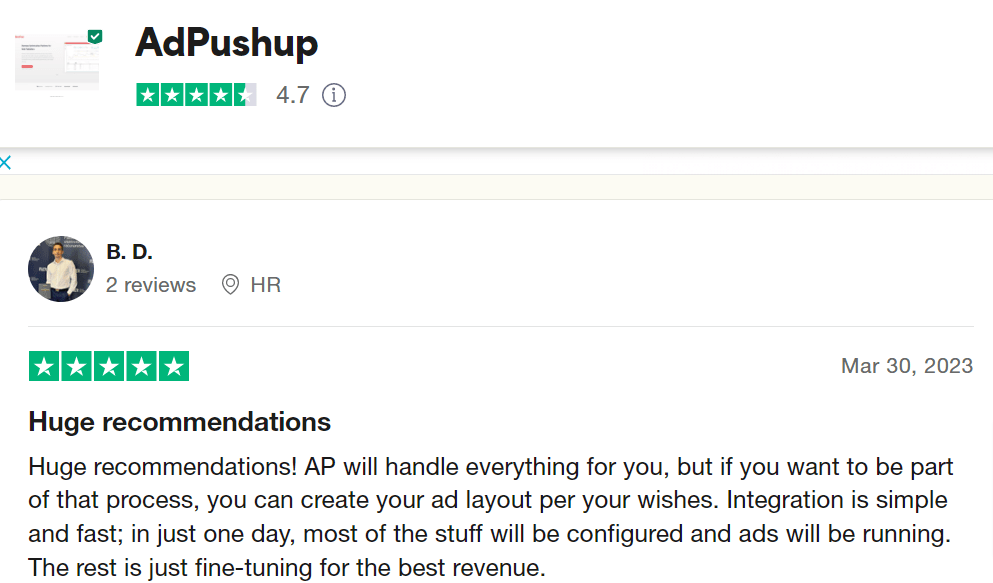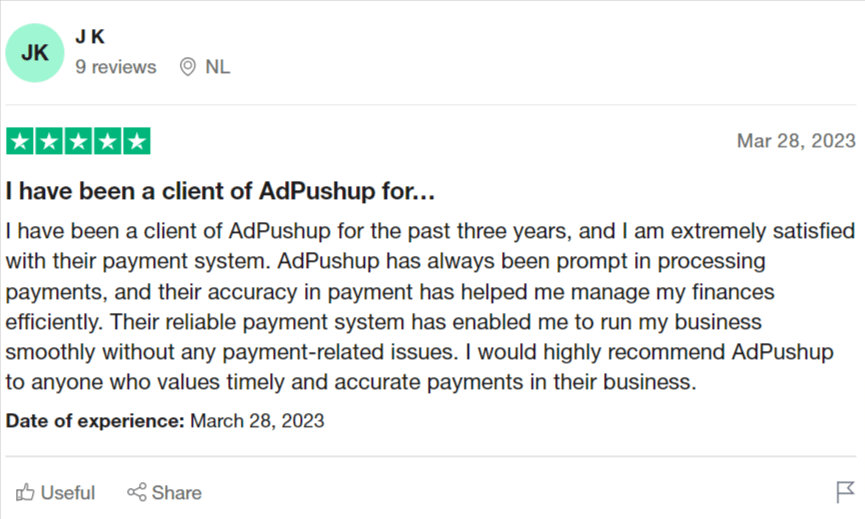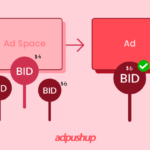While publishers are facing economic downturn challenges today, there are also more monetization opportunities than ever in 2023. Getting it right in terms of monetization is not just about generating traffic – it’s about choosing the highest paying ad network. In this blog, we have thrown light on how you can monetize your website and build a stable, reliable revenue stream.
So, you have a website with a significant number of visitors per day which, by the way, is increasing consistently. Keeping that in mind, you have finally decided to monetize it. The decision is great. However, you must give a fair bit of thought on how you can monetize it.
Well, there are many ways, but selling ad space is one of the most popular ones. Despite being popular, this method of revenue generation comes with its fair share of planning and execution. And if the planning and execution are not done correctly, you won’t be able to achieve what you want.
One of the early steps (actually the first step!) is to find the best and highest paying ad network that can help you monetize your website by enabling you to display advertisements.
An ad network offers high-quality ads, pays competitive rates, and provides a user-friendly platform to manage ad placements and revenue.
As a rule of thumb, your preferred ad network should be compatible with the website’s content and audience to ensure that the ads displayed are less-intrusive and relevant.
However, the question still remains – where to find an appropriate ad network? Isn’t that like mining gold? No, it’s not! It is way easier than that, and we will show you how.
Just keep reading.
What Is an Ad Network?
An ad network is a platform that connects advertisers with publishers who have available ad space on their websites or mobile apps.
Ad networks typically aggregate ad inventory from multiple publishers and match them with advertisers looking for ad slots. They act as intermediaries between advertisers and publishers, helping advertisers reach their target audience by displaying their ads on relevant websites and mobile apps.
For publishers, ad networks provide tools and services to manage ad placements, track performance, and optimize ad campaigns. They also provide various targeting options, based on demography, geography, and audience behavior, to help advertisers reach their desired audience.
The highest paying content ad networks generate revenue by taking a percentage of the ad spend from advertisers or charging a commission from the revenue earned by publishers.
How Does an Ad Network Work?
An ad network connects advertisers who want to display their ads with publishers having ad space available on their websites or mobile apps.
On the Supply Side
Ad networks gather ad inventory or impressions from publishers by collecting inventory directly from publishers’ websites or buying impressions in bulk.
The ad network then sorts the ad inventory based on price, audience, or other criteria to make it more appealing to potential advertisers. The ad network can then sell these impressions to app marketers, agencies, or advertisers.
On the Demand Side
Ad networks offer a platform for advertisers to sign in and manage their advertising campaigns. Advertisers can set up their targeting options, budget, and ad creatives to be displayed on publisher websites or mobile apps.
Ad networks may also offer a managed service where account managers act as consultants to optimize campaigns for optimal performance.
All in all, ad networks enable advertisers to save time and effort by streamlining the process of finding relevant ad inventory and managing their campaigns. Publishers can also benefit from ad networks by maximizing ad revenue and connecting with a broader range of potential advertisers.
– Some examples of highest paying ad networks are AdPushup, Google AdSense, Media.net, and Publift, among many others.
What are The Different Types of Ad Network?
There are several types of ad networks, each with its unique features and benefits. Here are some of the most common types of ad networks:
Vertical Ad Networks
These ad networks focus on a specific industry or vertical, such as automotive, travel, or healthcare. Vertical ad networks provide advertisers with a more targeted audience and allow publishers to connect with relevant advertisers.
Horizontal Ad Networks
Horizontal ad networks cover various industries and topics, providing a broad audience for advertisers and publishers.
Read More: Horizontal Vs Vertical Advertising
Mobile Ad Networks
Mobile ad networks specialize in serving ads on mobile devices, including smartphones and tablets. They offer various ad formats, such as banner ads, interstitial ads, and native ads, optimized for mobile devices.
Video Ad Networks
Video ad networks specialize in serving video ads across multiple platforms, including desktop, mobile, and connected TV. They offer different video ad formats, such as in-stream ads, out-stream ads, and interactive video ads.
Native Ad Networks
Native ad networks serve ads designed to look and feel like the surrounding content, providing a seamless user experience. Native ads can be displayed on both desktop and mobile devices.
Programmatic Ad Networks
Programmatic ad networks use real-time bidding (RTB) and machine learning algorithms to match ad inventory with demand from advertisers automatically. Programmatic ad networks can help advertisers target specific audiences and optimize their campaigns in real-time.
Social Ad Networks
Social ad networks serve ads on social media platforms like Facebook, Instagram, and Twitter. They offer various ad formats, such as sponsored posts, video ads, and carousel ads, to help advertisers reach their target audience on social media.
Each type of ad network has advantages and disadvantages, and choosing the right one depends on the advertiser’s goals, target audience, and budget.
How Does a Highest Paying Ad Network Benefit a Publisher?
Ad networks provide several benefits to publishers. These include:
Increased Revenue
Ad networks help publishers generate additional revenue by providing access to a broader range of advertisers and ad inventory. Publishers can maximize their ad revenue by displaying relevant ads to their audience and earning a share of the revenue generated by the ads.
Simplified Ad Management
Ad networks simplify managing ad placements by providing tools and services to automate the process. Publishers can easily manage their ad inventory, track performance, and optimize campaigns.
Access to Advertisers
Ad networks connect publishers with a wider range of potential advertisers, increasing the chances of finding relevant ads for their audience. It helps publishers build relationships with advertisers and generate repeat business.
Improved User Experience
Ad networks offer a range of ad formats optimized for different devices and platforms, providing a better user experience for the publisher’s website or mobile app. Ad networks can also provide tools to help publishers manage the frequency and placement of ads to ensure a positive user experience.
Monetization of Unsold Inventory
Ad networks can help publishers monetize unsold ad inventory by providing access to demand from advertisers. It ensures that publishers make the most of their available ad space and generate revenue from their traffic.
How Do Ad Networks Help Generate Revenue?
If you have a website with a significant number of visitors, you can generate revenue from displaying ads. Here’s how you can make money from ads.
Display Advertising
It involves displaying ads on the website or mobile app and earning revenue based on the number of impressions, conversions, or clicks generated by the ads. You can work with the highest paying ad networks for advertisers to display ads on the site.
Affiliate Marketing
In affiliate marketing, you promote products or services on your website or social media channels and earn a commission for each sale or lead generated through your affiliate link.
Sponsored Content
You can generate revenue by publishing sponsored content on your website or social media channels. Sponsored content is typically created by an advertiser and promoted through the channels of the publishers to reach your audience.
Essential Metrics to Generate Revenue from Ad Networks
Generating revenue with ad networks is relatively easy. However, it can become difficult if the following things are not in your favor:
Website Traffic
The more traffic your website or mobile app receives, the more revenue you can generate from ad networks. You can increase your website traffic by creating quality content, optimizing your website for SEO, and promoting content on social media.
Multiple Ad Networks
You can maximize your ad revenue by displaying ads from different sources using multiple ad networks. It can also help you diversify your revenue streams and reduce the risk of relying on a single ad network.
Optimized Ad Placements
You can find the optimal ad locations on your website or mobile app by experimenting with different ad placements. It can help increase click-through rates and revenue generated from ad networks.
Ad Optimization Tools
Ad optimization tools can help you identify the most profitable ad formats and strategies for your website or mobile app. These tools can also help you monitor and optimize ad performance to maximize revenue.
Relevant Advertisers
By targeting advertisers relevant to your website or mobile app’s content and audience, you can increase the chances of displaying appropriate ads that will generate higher revenue.
Higher Rates
You can negotiate higher rates with ad networks or advertisers if you have an excellent quality high-traffic website or mobile app. It can increase your revenue per ad impression or click.
Read More: Where To Place Your Ads? 5 Best Ad Placement Strategies (2023)
Tips for Making More Revenue with Ad Networks
By following the tips, you can maximize your ad revenue and build a sustainable business model with ad networks.
Focus on High-Paying Niches
Certain niches pay higher than others, so choosing a niche that is in demand and pays well is important. For example, finance, technology, and healthcare are known for having higher ad revenue than other niches.
Test Different Ad Formats and Placements
Testing different ad formats and placements can help you find the most effective strategies for maximizing ad revenue. Experiment with different ad formats, such as banner ads, native ads, and video ads, and test different ad placements, such as above the fold or in the sidebar.
Focus on User Experience
Providing a good user experience is important for retaining visitors and generating revenue from the highest paying ad networks. Avoid using too many ads or intrusive ad formats that may negatively affect the user experience.
Monitor Ad Performance
It’s important to monitor your ad performance and regularly adjust as needed. Use analytics tools to track ad clicks, impressions, and revenue generated from ad networks and change your ad placement and formats accordingly.
Optimize for Mobile
As mobile usage continues to grow, optimizing your website or mobile app for mobile devices is becoming important. Make sure your ads are mobile-friendly and display properly on different devices to ensure a good user experience and maximize your revenue.
How Ad Networks Determine Payments (Payment Models)?
Ad networks use a variety of factors to determine payments, including the type of ad format, the advertiser’s bid, the publisher’s website or app quality, and the ad’s performance. Here we outline key considerations to keep in mind when determining payment models:
Cost-Per-Click (CPC)
In this model, advertisers pay the ad network each time users click on their ad. The highest paying ad network then pays a portion of the revenue to the publisher. It is an important metric to consider, since it measures the price for a brand’s paid ad campaigns.
Cost-Per-Impression (CPM)
In a CPM model, advertisers pay the ad network based on the number of impressions on the ad. The ad network then pays the publisher a portion of the revenue based on impressions generated on their website or app. As a rule of thumb, you should always prefer the highest paying cpm ad network
Cost-Per-Action (CPA)
In the CPA model, advertisers pay the ad network each time a user takes a specific action, such as purchasing or filling out a form. The ad network then pays the publisher a portion of the revenue based on the actions generated on their website or app.
Revenue Share
In the revenue-sharing model, the ad network takes a percentage of the ads’ revenue. It pays the remaining revenue to the publisher whose website or app displayed the ad.
Also Check: Understanding CPC vs CPM for Ad Publishers
What are the Most Common Payment Issues of Ad Networks?
Many website owners face payment issues with their ad networks. These issues are sometimes frustrating. That said, it does bring along a bunch of challenges that most publishers are now struggling to overcome. Here are some of them:
Trust
One of the most significant payment issues faced by publishers is trust. Publishers often feel concerned about whether they will receive their payments on time or not.
Payment Cycle
Payment cycles can also be an issue, as some highest paying ad networks may have longer payment terms or delay payments, which can affect cash flow for both publishers and advertisers.
Transparency
Transparency in payment procedures is also an important factor that publishers should consider. It needs to be answered before committing to one network or another. Publishers may not know about the payment procedure or about the received funds, leaving them with confusion particularly making multiple payments for the ads.
Hence, a reliable ad network must give access to all sorts of data related to payment terms, payment methods, revenue share policies, which ultimately helps build trust among publishers and advertisers.
What Should You Look for in Ad Networks Before Joining?
There are many factors to consider when joining an ad network. Publishers should join a network that helps generate the best ad revenue possible. Here are a few more things you must consider before deciding which ad networks to go with:
Revenue Share
It is important to ask about the revenue share percentage offered by the ad network. You should also ask whether the revenue share percentage is fixed or varies depending on the ad format, target audience, or other factors.
Net Payment Terms
You should ask about the payment terms, including the frequency of payments, and minimum payment threshold. Some ad networks offer weekly or monthly payments, while others may require a higher minimum payment threshold or longer processing time.
Payment Methods
You should also ask about the payment methods available and whether they suit you. Some common payment methods include wire transfer, PayPal, ACH, or cheque. Some ad networks may charge fees for certain payment methods, so asking about any associated fees is important.
Notice Period and Contract Lock
It is important to ask about the notice period and contract lock-in period. The notice period refers to the time required to terminate the agreement, while the contract lock-in period refers to the minimum duration of the contract. You should ask about any penalties or fees associated with terminating the contract before the end of the lock-in period.
Ad Quality and Targeting
Publishers should also ask about the ad quality standards and targeting options the highest paying content ad network offers. Ensure that the ads displayed on a website are relevant, high-quality, and not intrusive to your users. Also, ask about the ad targeting options, such as geographic, demographic, or behavioral targeting, to ensure that the ads displayed are relevant to the audience.


Partner with The Highest Paying Ad network
An ad network platform is an “all-in-one” solution meant to help publishers manage their ads on websites and mobile apps. It can be considered the “easy” button for ad management.
If you’re new to the game or haven’t quite yet found the best ad network, you can definitely trust AdPushup. We are one of the best and highest paying ad networks for website owners to get started with. The integration and setup process is quite straightforward.
The platform also helps publishers automatically test different ad formats and place ads on the website based on user behavior. We also help save time and effort while still generating a significant amount of ad revenue.
Let’s take a closer look at all the main features offered by AdPushup:
AdPushup is a high-paying CPM ad network that offers full-stack monetization to help publishers generate maximum revenue from their ad inventory. We provide a centralized dashboard that displays critical data such as total revenue, eCPM, revenue by browser and country with just one click.
AdPushup’s product suite includes a Header Bidding solution, a comprehensive video monetization solution (including a free video library), an AI-powered floor engine called ‘FloorSense‘ that dynamically sets price floors and provides a significant revenue uplift, and AdRecover, a solution for monetizing AdBlock traffic that helps publishers recover lost revenue.

With AdPushup, publishers also get access to more than 50,000 premium brands, advertisers, and agencies, along with header bidding solutions, AMP Ads, Ad Mediation, Google AdX, Google Ad Manager, and PMP deals. You’ll also have 24X7 support on the phone from a dedicated account manager.

What more you need to know:
- Payout Type: CPM
- Net 45 days payout schedule
- (Percentage Revenue Share)- Not fixed- incentives aligned
- – (minimum pageview threshold)- for machine learning and to kick in
AdPushup connects the publishers with several ad networks, which not only improve eCPM but also increase ROI. Essentially publishers can unlock the whole world of ad management and revenue optimization with AdPushup.

Shubham is a digital marketer with rich experience working in the advertisement technology industry. He has vast experience in the programmatic industry, driving business strategy and scaling functions including but not limited to growth and marketing, Operations, process optimization, and Sales.




![CTV vs OTT Advertising: Which one is Right Pick for Publishers? + [6 Bonus Strategies] Ott vs Ctv](png/featured-image-270x180.png)


